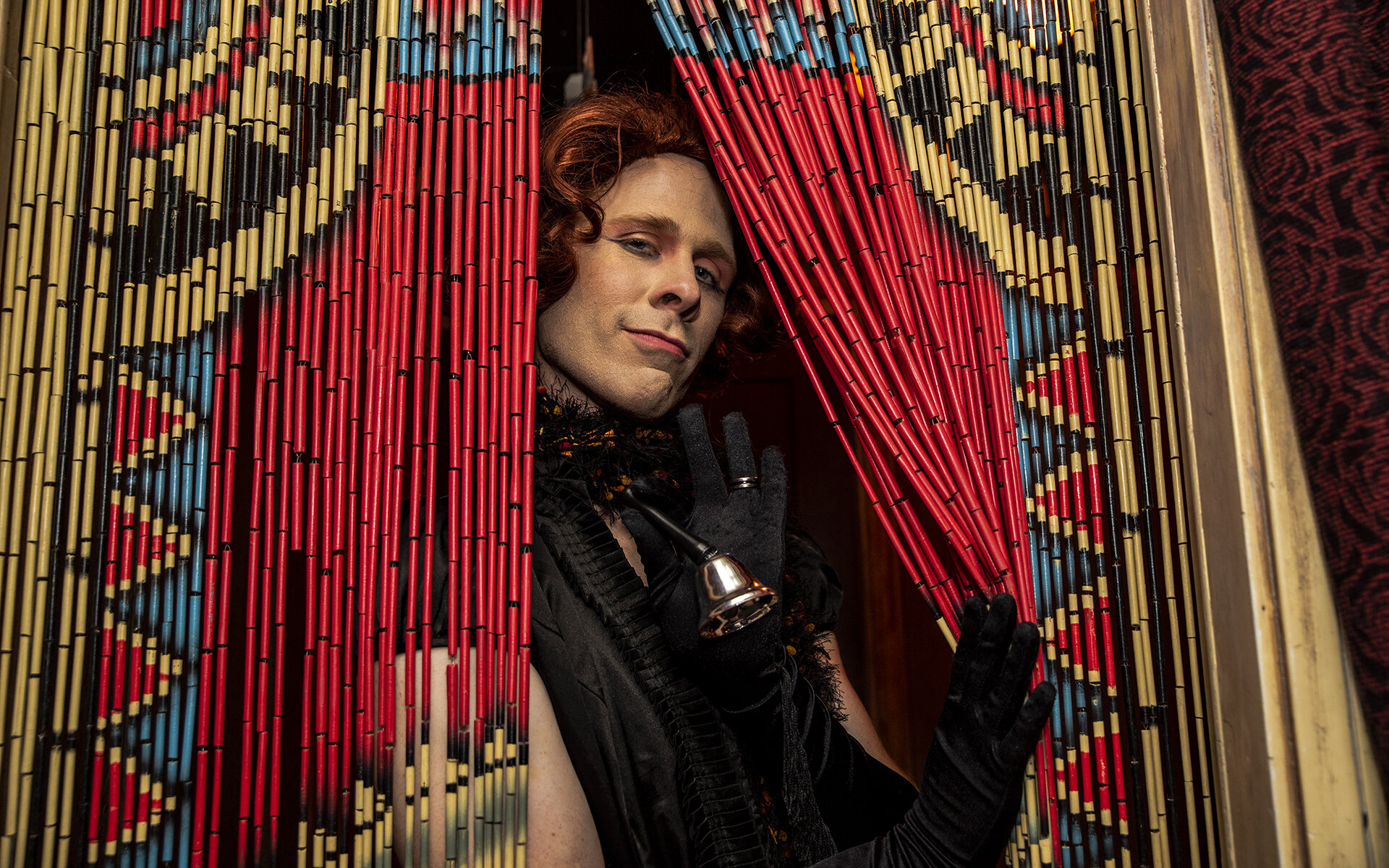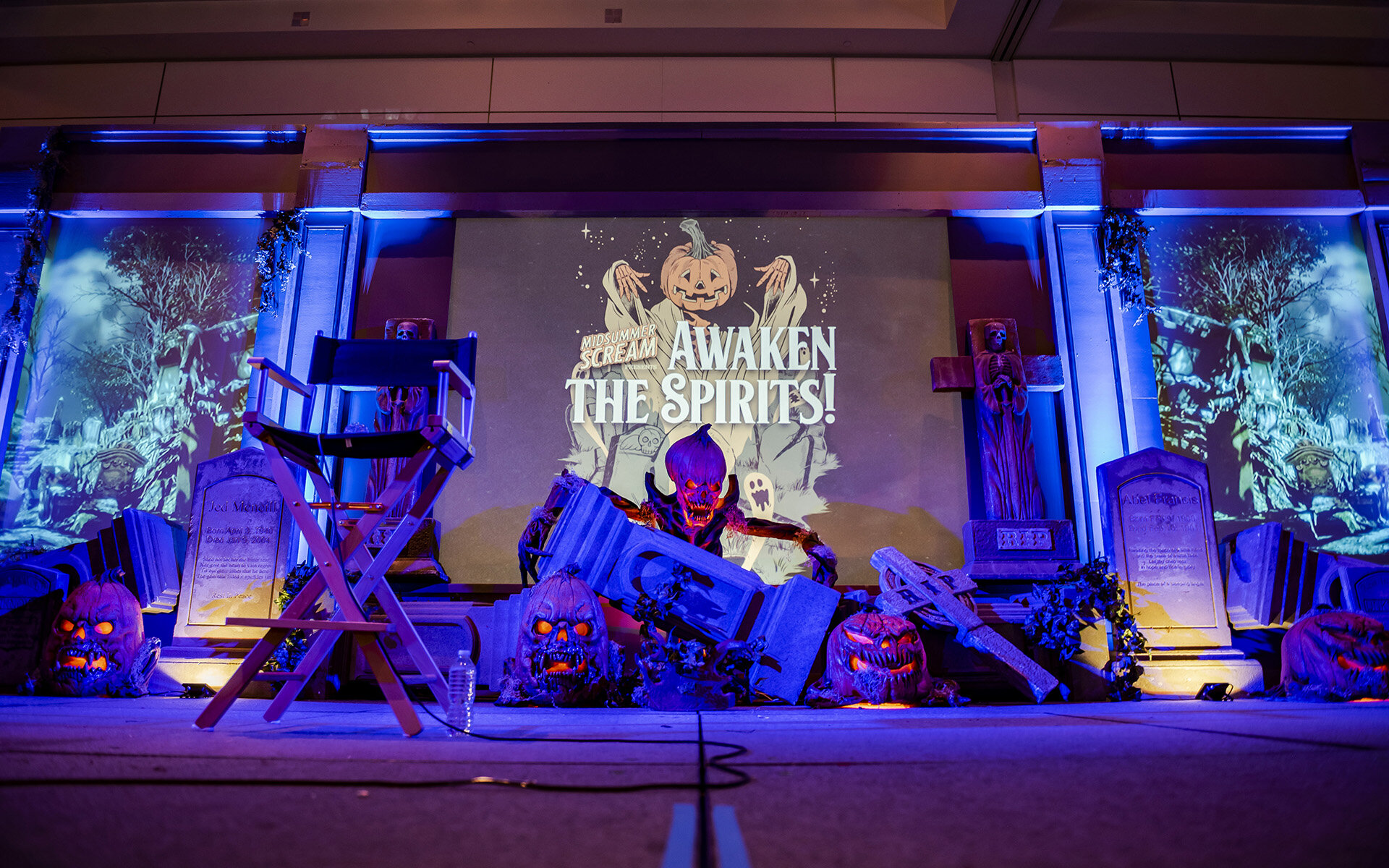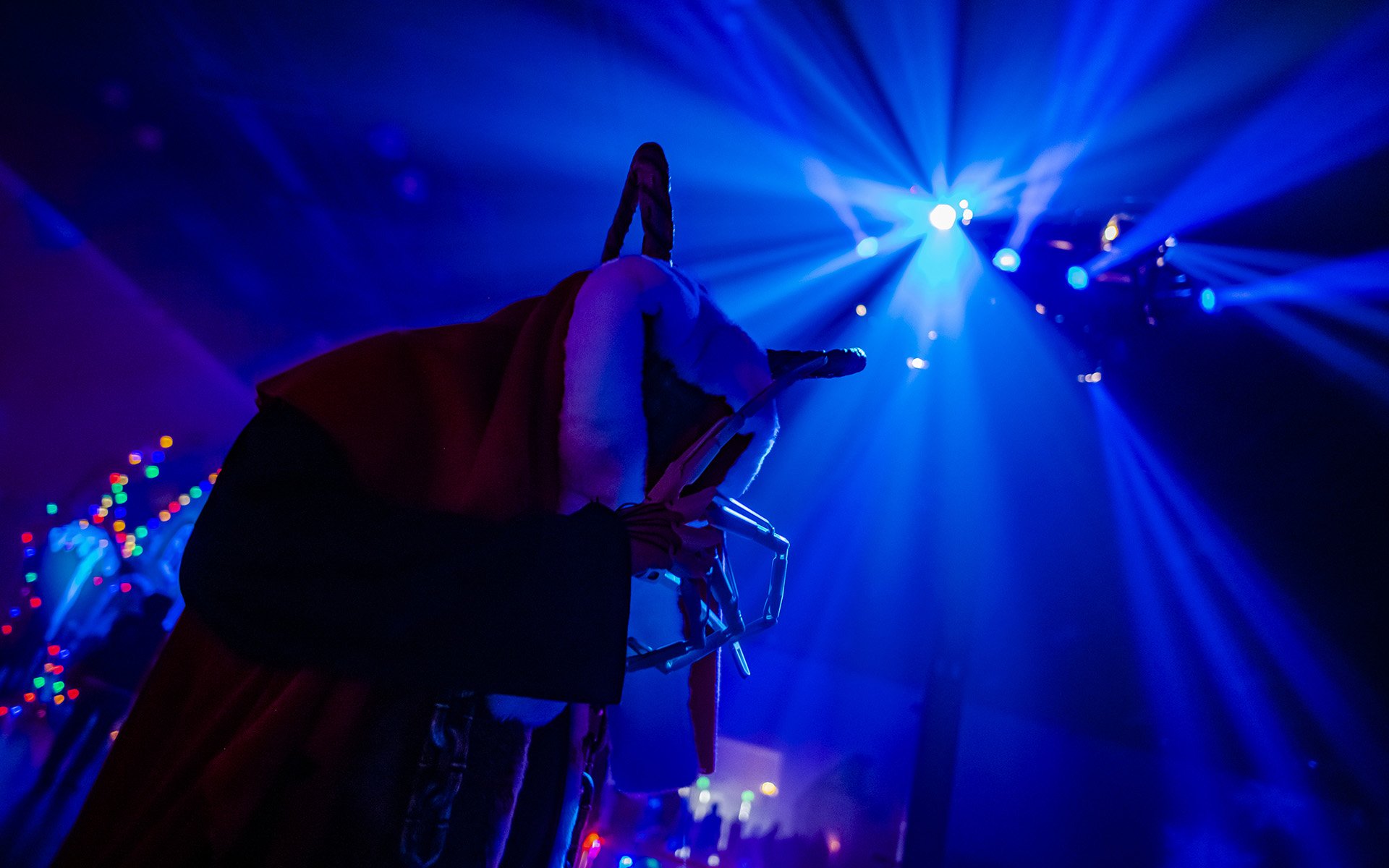Lost Spirits Distillery

Lost Spirits Distillery, Los Angeles, CA
What do you get when you take Willy Wonka’s Factory, replace the chocolate with alcohol, stir in a bit of the Enchanted Tiki Room, and blend it all together under the adventurous guise of a group of scientifically-minded experimenters with a penchant for reverse engineering and no obligations to tradition? Well, if you’re located in the Arts District of Downtown Los Angeles, you get Lost Spirits Distillery, a destination that has made waves in the alcohol industry—both for the way in which it produces its potables and for the way in which it guides visitors through that process!
The entrance of Lost Spirits is lively and colorful, but it’s also not exactly obvious if the door is closed.
Lost Spirits is the creation of Bryan Davis and business partner/girlfriend, Joanne Haruta. Part of a five-person ownership and management team that runs every aspect of the business, from the distillery, bottling, and distribution to the design, construction, and production of tours, Bryan and Joanne have spearheaded an operation that has broken rules and turned a very establishment-centric trade on its side. Using science to essentially reverse engineer aged spirits, Bryan, Joanne, and their team have utilized custom-designed, proprietary equipment to analyze and categorize rums and whiskies into their basic flavor components, then derive the chemical compounds used to create those tastes, and figure out a way to fast-track a method of spirits production that allows liquors normally requiring aging of a decade or more to be churned out in only days.
But more on the scientific part later.
One of many experiments at Lost Spirits.
The story of Lost Spirit begins back in 2010, in Salinas, California, where Bryan and Joanne had just returned from Spain after a five year jaunt in their start-up distillery making and selling absinthe and gin. In Monterey County, with $80,000, they built another distillery on some land owned by Joanne’s parents.
From the very beginning, the team was tinkering around with ways to speed up the production of spirits—first with whisky in the form of releases like the “Seascape” and “Leviathan” series, “Calafia,” and “Umami.” But then, after a few years, they turned to rum, bringing forth elixirs like their “Navy Rum,” “Cuban Inspired Rum,” and the “Polynesian.” Following the footsteps of fabled Jamaican rum production methods, which supposedly boasted of burying things as understandable as jackfruit or banana to as strange as a dead goat (which might not have actually been a goat) to introduce microbes to unaged spirits, Bryan set off on the first steps toward what would eventually be a breakthrough discovery that would change the course of Lost Spirits forever.
Evaporation during the aging of whisky was explained in the early days of spirits distillation as losing alcohol to the “angel’s share.” Lost Spirits has taken a sarcastic reference to this in their lab.
In 2014, Lost Spirits released their “Colonial Inspired Rum” to great acclaim, winning top marks from a variety of critics across the industry. But their follow-up release would prove to be even more ground-breaking. This wasn’t another elixir, but rather the revelation of how they had created said rum. Instead of going through the traditional process of distilling alcohol and adding the flavor and letting the brew age in barrels for said number of years, the Lost Spirits team had figured out how to condense this entire timeline down to less than a week. Accompanied by scientific backup, Lost Spirits demonstrated how using wood chips broken down by super-intense, sunlight-mimicking illumination could impart the esters that give aged spirits their unique flavors into their concoctions. Under the correct conditions, and using technology that Bryan patented, the accelerated process resulted in something that had the chemical makeup of rum that was aged 15-20 years old.
The secret to this lay in the team’s confirmation that the aging of spirits is actually a catalyzed process—that is, an actual chemical reaction occurs between the wood casks in which virgin liquor sits and the alcohol itself. The insight actually came to Bryan one day after he noticed how the sun had weathered and split apart the outdoor deck of his home. Over the years, that exposure to sunlight had broken apart the polymers of the wood itself. If that sequence could be recreated in a laboratory, but sped up by increasing the intensity of light that simulated the same effects of the sun, then perhaps alcohol that normally took years to make could actually be done in a much shorter timeframe.
Lost Spirits’ super hi-tech equipment used to super-accelerate the aging of its liquors.
After that, there came further experiments to determine how other chemical compounds affected the other general profiles of a rum or whisky. This wasn’t about determining the ingredients to inject into Lost Spirits’ mixtures in order gain the associated tastes—notes like smoke or berries or leather or bark or citrus. It was about figuring out how one wanted the final product to taste like, then deriving the esters—those chemical compounds that tell the brain what food product to associate a flavor—to mix into the rum or whisky under production. All of this was—quite literally—a giant science project. And each line of spirits was a completely different adventure to attain the desired results!
Lost Spirits’ 2014 announcement that it had conjured a stable method of producing expedited aged alcohol caused quite a stir in the industry, even alienating some traditional minded folks who thought what the company was engaging was an abomination. Humorously enough, they would use that word as a fitting monicker in a later line of whisky. But the new buzz gave Bryan and company the incentive to retreat into the lab to perfect and fine-tune their process, constructing a machine to better and more consistently deliver their accelerated spirits aging.
During Prohibition, bootleg bars were often frequented by patrons “drinking tea.” Guests at Lost Spirits can do the same.
Fast forward a couple of years. With their penchant for experimentation and innovation, Lost Spirits moved their distillery from outside Salinas to just outside the heart of Downtown Los Angeles. Having gained much fanfare and a rather spirited (pun intended) cult following among booze enthusiasts, the new facility was constructed to allow a glimpse into the tinkering, in an environment that itself would be constantly tinkered with, for an audience who appreciated the tinkering. Initially, only industry guests were allowed. Early walkthroughs lasted hours, were often heavily scientific, and even included a technically-inclined Powerpoint presentation!
But as Bryan and the team began stretching their creative design muscles on what the distillery experience could be, they started branching outside of the sterile production plant environment. Having long been fans of Disney themselves, Bryan and Joanne realized that if the alcohol that Lost Spirits produced could be so cutting edge, yet out of the box, and fun and adventurous at the same time, why shouldn’t their distillery?
The setting can sometimes become mysterious and rugged at Lost Spirits.
The team went back to work again, this time crafting a story-driven environment that incorporated theatrics, theming, and actual amusement park attraction components. And by the middle of last year, Lost Spirits debuted a new distillery tour that quickly began making new waves as one of the distillery tours around. Some called it the “Disneyland of liquor.” Others likened it to something out of Willy Wonka. But mostly, people were just blown away at how fun and enchanting this tour of an alcohol production plant could be.
What might seem to be decorative fixtures actually serves as part of the spirits-making equipment at Lost Spirits.
Today, Lost Spirits is open to guests by reservation only. Tours last two hours on average and take on groups of up to 12 people. Of course, given the nature of the tour, only guests 21 years of age or older are allowed. But past those details, this is far from an ordinary guided excursion. Visitors must sign a waiver of liability for their safety before they begin the tour, and there are some interesting details within the document. There’s mention of rough and uneven terrain, exposure to moving ride conditions, and even the potential for a water evacuation! Just exactly what kind of an experience is this anyway??
Well, the answer is an immersive, thematic, dynamic, and constantly changing one. Before the tour even begins, visitors can meet one of the innovations at Lost Spirts: TESSA, an autonomous computer system that runs the distillery. Think of it as the booze-inventing version of Tony Stark enlisting his own JARVIS to help run his headquarters (although since TESSA is female, I suppose it would really be FRIDAY). TESSA is present in the restroom as well as the opening room—a bit of A.I. wizardry to charm the tour members.
Guests then filter through various spaces within Lost Spirits’ workshop, each explaining some part of the history or procedure of distilling and aging spirits. There’s a dining room with a distinctively Island of Doctor Moreau flair, as well as a jungle rainforest that requires guests to board a boat to reach (hence the potential for water evacuation), not to mention a fully-functional carousel to Whisky Island (the best island of all). And that’s only a small sampling of the tour scenes!
Graze into the domain of Moreau-inspired tent.
Boat ride? Yes, Lost Spirits has a boat ride.
What amusements beckon beyond?
Each space supports the part of the story being told, be it how alcohol distillation actually occurs or how the accelerated aging is conducted or how the Lost Spirits folks had to go on a wild goose chase to acquire an exceedingly rare bottle of a vintage spirit in order to chemically analyze it for tasting notes to inform the proper balance of a rum in order to create the perfect mai tai. There is an infectious sense of fun as guests move from area to area, enveloped by the ambiance of a theme park while learning the functionings of a distillery. When teachers promote the idea of making education entertaining, they ought to look to Lost Spirits for inspiration (just, perhaps minus the alcohol—you know, for the sake of the children). And of course, at select rooms, guests can enjoy tastings of some of Lost Spirits’ current products.
Smartly, many of the areas that might seem to be only designed as a themed experience actually play double duty as functional parts of the distillery. The river through which the barge sails to reach the jungle, for example, is actually a cooling tank for the fermenters and stills. The mix of engineering and whimsy really enhances the already otherworldly experience. And if that isn’t enough, the finale, which routes guests into a souvenir shop of sorts, features a raucously hilarious parody of the Enchanted Tiki Room. Only instead of singing, these international (and much more robotic-sounding) birds are master sales-parrots. Tweet tweet. Chirp chirp. Come grab these great deals.
The gift shop has gone to the birds. Almost literally.
In the spirit of Walt Disney himself, Lost Spirits is similarly a land that apparently will never be finished. The team is constantly changing up spaces and creating new environments. Back in February of this year, guests entering the site were immediately greeted by a pair of animatronic dinosaur topiaries flanking the lobby area where visitors filled out their waiver and waited until the tour start time. By November, that had been replaced by a long and dramatic hallway clad in exotic drapery, yielding a bit of an Indiana Jones Temple of the Forbidden Eye effect (minus the Mara). Similarly, the first room was a moody outpost and bar deep in some secluded wilderness at the beginning of the year. Last month, it was an in-the-round space sheltered by an opulent chandelier and cascading waves imbibing the aquatic theme carried by the connotations of the company’s Navy Rum. In February, the actual laboratory area was mostly an industrial setting. By mid-autumn, it had acquired a bit more of a furnished, private club appearance.
A dramatic hallway leading from the lobby at Lost Spirits.
It starts with rum, since rum is what gave Lost Spirits its big break.
The five-person leadership team at Lost Spirits is constantly shuttling ideas—sometimes into reality and sometimes not. Earlier this year, there was talk of constructing a cabaret to accent the story of one of the spirits, but that didn’t really pan through. In autumn, the team had an idea of constructing a Transylvanian-esque lounge to accompany an elixir of Hungarian moonshine they were working on, which would have been a fitting complement to the Halloween season, but scheduling on both the lounge and the libation didn’t quite make the seasonal deadline. Currently, the focus is on creating an actual tasting room that will be separate from the tour, which will allow a more casual ambiance to simply try the various lines of Lost Spirits rums and whiskies. It’s got a bit of a carnival theme to it, and one can bet that there will be some captivating surprises programed in! The tasting room is schedule to open early next year.
As wonderful and intriguing as all of this sounds, it’s all the more impressive when one considers that the majority this entire endeavor—the imagining, design, and construction, installation, and programming of each of the spaces—has been done in-house, by Bryan and Joanne and their co-owners. More recently, Lost Spirits has also been working with John Berry Architects for the architectural elements of their latest changes. But this constant drive to continue to innovate and alter and expand also makes for a great return value. Come back several months or half a year later, and the tour is likely to contain some brand new parts not previously seen. It truly is a labor of love, mixed with a bit of craziness!
New work is always abound at Lost Spirits.
What looks like an exotic door hardware detail was actually a refinished theming element from a closed branch of a certain themed restaurant chain.
This mad scientist brew has become the talk of the town among boozehounds and appreciators. Lost Spirits has been named the “World’s Best Distillery Tour” two years in a row by Drinks International London. That’s in addition to the same accolade from groups like Drinks International, the American Distilling Institute, and The Spirits Business UK. Its products continue to receive critical acclaim too. Last year, its Islay-style “Abomination” whisky received a Liquid Gold Award in Jim Murray's Whisky Bible, adding that to the distillery’s long list of distinctions.
But it’s that theme park style experience that really makes Lost Sprits unique (and why I’ve dedicated over 2,300 words to this post and featured it on an article on this site). The two hour tour really flies by, feeling like half the time, and the amount of enjoyment from the sheer experience of it all is absolutely marvelous. Lost Spirits revives some of that child-like fantasy into a tour and place that doesn’t normally expect such inventiveness. Plus, with the imminent opening of the tasting room, there will be more fancy to enjoy. Lost Spirits is well worth a trip over to Downtown L.A. to check out what the buzz has been about. It’s undoubtedly a world of pure, distilled imagination!
Lost Spirits has picked up plenty of honors.
Lost Spirits requires online reservations to visit. It is not open to the public, nor does it sell to the public. The alcohol atelier is located at 1235 E 6th St, Los Angeles, CA 90021. Metered parking is available on the street (it’s free on Sundays), though it can sometimes be a little challenging to nab a spot. A paid parking lot is also available just east of Lost Spirits, on the very same 6th Street. Tours are currently $37/person. For more information, visit Lost Spirits’ web site at https://www.lostspirits.net/.
Ornate, elegant, scientific, esteemed, and liquored. That’s Lost Spirits in a nutshell!
Architect. Photographer. Disney nerd. Haunt enthusiast. Travel bugged. Concert fiend. Asian.





















